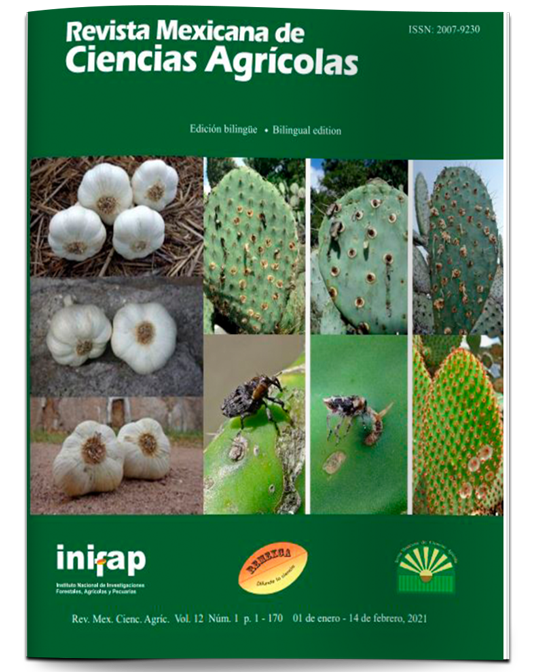Micropropagation of the caper in semi-solid medium and in temporary immersion bioreactors
DOI:
https://doi.org/10.29312/remexca.v12i1.2411Keywords:
Capparis spinosa, cytokinins, RITAAbstract
The objective was the development of an efficient system for the micropropagation of the caper (Capparis spinosa L.), a woody shrub of great interest due to its products, its remarkable resistance to drought and its tolerance to high temperatures. In vitro cultures were first established through disinfection and seed germination. A scarification of these with concentrated H2SO4 (98% v/v) was necessary to break dormancy. Only 15% of the seeds germinated. Nodal segments were obtained from the germinated seedlings, which were cultivated in basal medium of Murashige and Skoog (MS) semisolid added with benzyladenine (BA), 2-isopentenyladenine (2iP) and metatopoline (MT), this in order to induce multiple sprouting. The best response was obtained with 2 mg L-1 of these cytokinins, with an average number of well-differentiated sprouts per nodal segment of 3.6 with MT, 2.3 with BA and 1.5 with 2iP, this after 54 d of incubation. The combination of cytokinins with an auxin, naphthaleneacetic acid, was also tested. This combination improved the BA response, reaching an average of 3.2 sprouts per nodal segment. With the other cytokinins, it did not show a positive effect, maintaining very similar values with and without auxin. In addition to well-differentiated sprouts, masses or clusters of numerous small sprouts were generated, unsuitable for transfer to the rooting medium. These masses were transferred to RITA type temporary immersion bioreactors, where an average of 89 well-differentiated sprouts were generated per original explant, this in a medium with 1 mg L-1 of BA with 2 min immersions every 6 h. The sprouts took root with an efficiency of 80% in the basal environment, generating well-differentiated plants suitable for transfer to the ground. The survival already in the external environment of the plants generated in vitro was 85%, showing an apparently normal development already in ex vitro conditions.
Downloads
Published
How to Cite
Issue
Section
License
Copyright (c) 2021 Revista Mexicana de Ciencias Agrícolas

This work is licensed under a Creative Commons Attribution-NonCommercial 4.0 International License.
The authors who publish in Revista Mexicana de Ciencias Agrícolas accept the following conditions:
In accordance with copyright laws, Revista Mexicana de Ciencias Agrícolas recognizes and respects the authors’ moral right and ownership of property rights which will be transferred to the journal for dissemination in open access. Invariably, all the authors have to sign a letter of transfer of property rights and of originality of the article to Instituto Nacional de Investigaciones Forestales, Agrícolas y Pecuarias (INIFAP) [National Institute of Forestry, Agricultural and Livestock Research]. The author(s) must pay a fee for the reception of articles before proceeding to editorial review.
All the texts published by Revista Mexicana de Ciencias Agrícolas —with no exception— are distributed under a Creative Commons License Attribution-NonCommercial 4.0 International (CC BY-NC 4.0), which allows third parties to use the publication as long as the work’s authorship and its first publication in this journal are mentioned.
The author(s) can enter into independent and additional contractual agreements for the nonexclusive distribution of the version of the article published in Revista Mexicana de Ciencias Agrícolas (for example include it into an institutional repository or publish it in a book) as long as it is clearly and explicitly indicated that the work was published for the first time in Revista Mexicana de Ciencias Agrícolas.
For all the above, the authors shall send the Letter-transfer of Property Rights for the first publication duly filled in and signed by the author(s). This form must be sent as a PDF file to: revista_atm@yahoo.com.mx; cienciasagricola@inifap.gob.mx; remexca2017@gmail.
This work is licensed under a Creative Commons Attribution-Noncommercial 4.0 International license.



